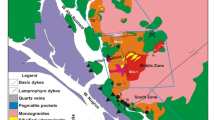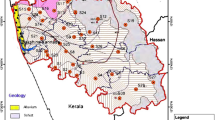Abstract
A specific, radium bearing type of barites has been known from the Ohře (Eger) Rift, a region of Cenozoic volcanic activity in northwestern Bohemia, Czech Republic, since 1904. Barites from Karlovy Vary, Teplice and Děčín areas have been studied to elucidate geochemical history of these specific samples. Low background radiometric method using high-resolution gamma-ray spectrometry has shown that radioactivity of these barites (up to 8 Bq g−1) is carried by 226Ra, which is not in equilibrium with the parent 238U. In all samples, uranium activity was below 0.005 Bq g−1––the detection limit achieved by instrumental neutron activation analysis. The alpha track method on a crystal plate has shown that 226Ra is accumulated in surface layers or crystal cracks, therefore, the crystal rims must be relatively young, not older than 10–15 thousand years. In a lead fraction isolated from the barites, concentration and isotopic composition of lead were determined by photon activation analysis and ICP MS, respectively.




Similar content being viewed by others
References
Knett, J.: Indirekter Nachweis von Radium in den Karlsbader Thermen. Sitzungsber. Akad. Wiss. Wien. 113, 753–762 (1904)
Ulrych, J., Adamovič, J., Žák, K., Frána, J., Řanda, Z., Langrová, A., Skála, R., Chvátal, M.: Cenozoic “radioabarite” occurrences in the Ohře (Eger) Rift, Bohemian Massif: mineralogical and geochemical revision. Chem. Erde - Geochemistry 67, 301–312 (2007)
Zielinski, R.A., Otton, J.K., Budahn, J.R.: Use of radium isotopes to determine the age and origin of radioactive barite at oil-field production sites. Environ. Poll. 113, 299–309 (2001)
Tomita, J., Sakaguchi, A., Yamamoto, M.: Hokutolite collected from riverbed at Peitou Hot Spring in Taiwan: with emphasis on radiochemical studies. J. Radioanal. Nucl. Chem. 270, 567–574 (2006)
Fleischer, R.L., Price, P.B., Walker, R.M.: Nuclear Track in Solids: Principles and Applications. University of California Press, Berkeley (1975)
Tommasino, L., Armellini, L.: New etching technique for damage track detectors. Radiat. Eff. 20, 253–255 (1973)
Ettler, V., Mihaljevič, M., Komárek, M.: ICP-MS measurements of lead isotopes in soils heavily contaminated by lead smelting: tracing the sources of pollution. Anal. Bioanal. Chem. 378, 311–317 (2004)
Zachariáš, J., Adamovič, J., Langrová, A.: Trace element chemistry of low-temperature pyrites – an indicator of past changes in fluid chemistry and fluid migration paths (Eger Graben, Czech Republic). Geol. Carpath. 59, 117–132 (2008)
Faure, G.: Principles of Isotope Geology, 2nd edn. Wiley, New York (1986)
Acknowledgements
This work was supported by the following projects: 205/07/0522 (Czech Science Foundation), A3013302 (ASCR Grant Agency), IRPAVOZ 10480505, MSM 0021620855.
Author information
Authors and Affiliations
Corresponding author
Rights and permissions
About this article
Cite this article
Řanda, Z., Ulrych, J., Turek, K. et al. Radiobarites from the Cenozoic volcanic region of the Bohemian Massif: radiochemical study, history, and lead isotopic composition. J Radioanal Nucl Chem 283, 89–94 (2010). https://doi.org/10.1007/s10967-009-0095-6
Received:
Accepted:
Published:
Issue Date:
DOI: https://doi.org/10.1007/s10967-009-0095-6




